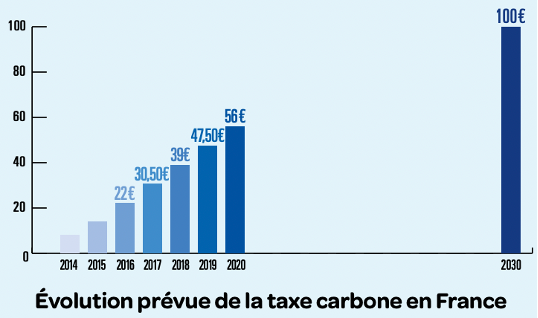What is carbon pricing?
Yes, Carbon has a price, and it is important!
It is an economic tool that aims to internalize the hidden costs of damage caused by greenhouse gas (GHG) emissions into market prices. Its objective is to encourage economic agents to adopt a low-carbon pathway.
The recent consolidation of carbon pricing
The carbon market was established in 1997, following the Kyoto Protocol, which took CO2 emissions into account when setting the price of carbon, since they represent more than ¾ of measured global GHG emissions.
The idea was to regulate the right to buy and sell GHG emission permits based on supply and demand.
In 2015, the Coalition for a Carbon Price (CPLC) was officially launched at the opening of COP21. This voluntary initiative brings together heads of state from 74 countries, but also leaders of more than 1,000 companies. Its ambition is to fuel a fruitful dialogue between public and private decision-makers on the opportunities to expand carbon pricing policies. Through its promotion as an effective tool to reduce emissions, the committed actors intend to cover at least 50% of global emissions by 2030.
Two major forms of carbon pricing coexist.
The carbon tax and carbon allowances are the two main tools currently established to set the price of carbon.
The simplest form is the carbon tax. Steadily increasing since 2014, the carbon tax has risen from €7 per ton to €56 in 2020, "until it reaches more than €90 in early 2022," according to the Bank of France. On June 22, 2022, the European Parliament validated the Commission's plan to institute a carbon tax at the Union's borders from 2023.
The sources notably concerned by the carbon tax are "small emitters" (small companies) or diffuse sources (vehicles, heating and hot water in buildings, agriculture...).

A more complex form of carbon pricing is the establishment of a Carbon Market. This trading system imposes carbon allowances, i.e. it limits the rights to emit carbon in a market.
The latter covers, in particular, high-emission sources. The industrial sector (fossil fuel-based electricity generation, large industries) favors the imposition of quotas over the carbon tax.
Since the Kyoto Protocol, many initiatives to establish carbon markets have been launched around the world, with the European carbon market at the forefront. Since 2005, the share of global emissions covered by a trading scheme has increased by 73%. These different systems are inspired by each other in their modalities, which must however be adapted to local specificities.
The European Commission intends to expand the Carbon Market. Last June, the European Parliament adopted its position by supporting its project to phase out the still free quotas in certain industrial sectors. In addition, airlines - from 2027, the maritime sector, road transport and building heating - from 2026, will in turn be forced to adapt their strategy to these new quotas.
In addition to these regulatory tools, many companies are themselves developing voluntary climate and csr carbon pricing initiatives, with the introduction of internal carbon prices.
Progress and turning point of the European carbon market
Whatever the pricing tool, the increase in the price of carbon aims to reduce its emissions in the future. On a global scale, this strategy intends to fight against environmental dumping from the rest of the world through "carbon adjustments at the borders" of the European Union.
The Carbon Price reflects the EU's ambition to transition to a low-carbon society. In 2019, " GHG emissions from industrial sites thus recorded their largest reduction, falling by 9.1%, or some 152 million tons of carbon dioxide equivalent less compared to 2018," according to the European Commission.
Today, the carbon market is at a turning point, as the European Commission intends to expand and strengthen it to make it truly effective.
On July 14, 2021, the Commission presented a series of measures, including a 2030 target involving a significant increase in carbon prices . This objective is part of the European Green Pact, which aims to reduce the EU's carbon emissions by 55% by 2030.
Finally, meeting on June 28, 2022, the European environment ministers adopted the 100% reduction in CO2 emissions from light vehicles by 2035. This text confirms the European Commission's ambitions to achieve the target of a 55% reduction in CO2 emissions by 2035, but also forms part of a more global approach to orienting market dynamics towards a low-carbon trajectory, and ultimately achieving carbon neutrality.
For further information on indirect emissions, we offer a guide to scopes 1, 2 and 3 of the carbon footprint.






